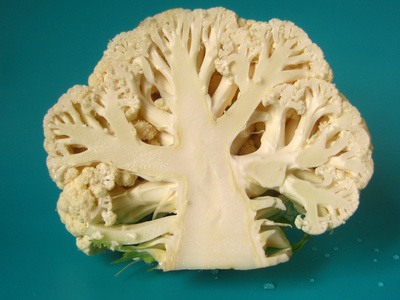I think the highly intelligent plant world is trying to tell us something with this chunk of cauliflower.
Doesn’t it look like a mid-sagittal section right out of a frontal lobe, complete with cerebral white matter?
Or, maybe networks of giant axons and dendrites. This head (whoa, it’s even called a head) of cauliflower appears to be a bit left-brain-heavy. What do you think? More neural pathways on the left side? Aaah, must be a linear thinker.
I’ll put aside my vivid imagination and interest in plant autopsies for a moment and talk about the healing power of whole foods. Most of us have enough bizarro stuff going on inside our heads that can sabotage our good intentions, let’s at least give our thoughts some powerful building blocks and mighty antioxidants to work with.
Food for thought
I can’t start this “brain food” list without commenting on gluten as a neuro-cootie. This is official – research has shown gluten to be a neuro-toxin (for some susceptible people). It can cause ataxia, epilepsy-like symptoms, peripheral neuropathy, depression, migraines, brain fog and a host of other neurological problems. In some rare instances, the neurological impact of gluten can even mimic ALS (Lou Gehrig’s Disease), MS and Parkinson’s Disease. Get tested for celiac disease if you have unusual neurological symptoms. A gluten-free, whole foods diet may (will) be beneficial. Check here for Dr. Rodney Ford’s take on this years ago. Scientific research is finally catching up to his diagnostic skills as a physician.
Nutrition for neurons (the basics)
• EFAs (essential fatty acids) are important for brain function. Wild-caught salmon and other cold-water fish, flax seeds, nuts, and pastured eggs are examples of foods rich in EFAs.
• Proper hydration is important for brain function. Dehydration causes the release of stress hormones, which impact neurons.
• Organic, whole foods rich in antioxidants should be the focus of a “healthy brain” diet. Antioxidants help prevent and repair cell damage.
• Sunshine stimulates the production of vitamin D, which is thought to aid in the protection of neurons. Plus, a little sunshine can boost your mood.
My top 8 food picks for brain health
This list is just a random assortment of nutrient-dense foods that I like and are high in antioxidant power. I’ve chosen foods that are easy to find and that people might actually eat. No need to scour the Amazon rainforest floor for some exotic plant or climb the Himalayas for a power-packed berry. Seriously, let’s make this easy. Organic is always best and I prefer eating the whole food rather than counting on supplements. That way you get a diverse combination of beneficial phytonutrients.
1. Cauliflower (I had no choice, this one looks like a brain)
Cauliflower is packed with vitamin C, a powerful antioxidant. Research is mounting that oxidative damage to brain cells may precede diseases like Alzheimer’s and other forms of dementia. One cup of raw cauliflower contains 94% of the daily value for vitamin C. It’s also anti-inflammatory and is a good source of protein, calcium, iron, magnesium, zinc and other plant goodies.
2. Wild-caught salmon (as mentioned above)
Please check out this past post I did on EFAs and why they are important for brain health. The post also includes a detailed break-down of omega-3s and omega-6s and a wonderful salmon recipe. Lots of good brain-building information in that post.
3. Blackberries, blueberries, cranberries, raspberries, strawberries, cherries.
All of these fruits are packed with antioxidants. Don’t stick with one choice – mix and match them for a variety of protective compounds.
4. Mustard greens
You’re probably thinking this is an unlikely choice for the top 8 brain foods, but I’ve decided it’s a good representative for leafy greens in general (kale, collard greens, spinach, chard). One cup of mustard greens, which I’ve recently become quite fond of, has 118% of the daily value of vitamin A and 65% of the daily value of vitamin C. It’s also a good source of vitamin E and it’s anti-inflammatory. A, C and E are all antioxidants, so this green is a good one to make friends with. I throw it in smoothies.
5. Coffee
Surprise, surprise! As those of you following this blog know, even though I’m a nutritionist, I don’t think coffee is evil. In fact, I like the stuff in small doses and guess what? It’s not only high in antioxidants, research indicates the caffeine in coffee has a neuroprotective effect. Choose organic coffee, use in moderation (1-2 cups per day) and don’t drink it later in the day.
6. Beans
Beans are a good source of easily-absorbed amino acids, which are important in the production of enzymes and neurotransmitters.
7. Organic, pasture-raised chicken eggs
Eggs are one of the best sources of high-quality protein. Pastured eggs are also high in omega-3s, vitamin A, vitamin E and B vitamins, all of which are important for healthy brain function.
8. Dark chocolate
Good, high-quality dark chocolate in moderation is a good source of antioxidants. Plus, a chunk of dark chocolate now and then puts you in a good mood and makes you a nicer person. I’m nicer when people give me chocolate. Aren’t you?
Peace, love and brain power!
Melissa















